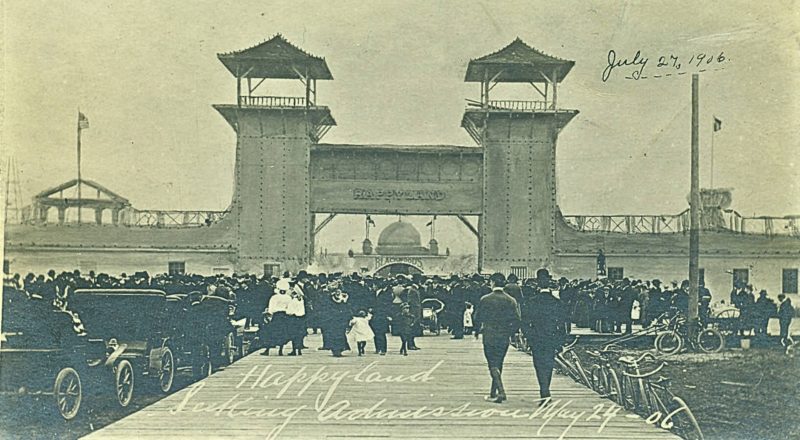
/ Blog
August 15, 2023
There Is A Happyland, Far, Far, Away
It was the kind of place that dreams are made of, where the imaginary is brought to life. Thrilling rides, electrifying performances, the latest in entertainment technology, spectacles from around the world – past and present – that all could be found in Winnipeg’s wondrous Happyland. It was an ambitious amusement park that shone brightly in the young prairie city at the beginning of the 20th century. But like a shooting star, a bright flash across the night sky, it was there and then it was gone, leaving behind only memories. Over a century later, conflicting stories and fuzzy details start to make one wonder: was there ever a Happyland?

An undated image of Happyland.
Source: Rob McInnes Postcard Collection (Winnipeg Public Library)
The property along the south side of Portage Avenue in the Woseley area was once owned by the Winnipeg Golf Club, the first gold club in the city. The club had a nine hole course where Vimy Ridge Park is located today, running down to the river. After about a decade of puttering around, the property was sold to an American amusement park company, who had a hopeful plan to build a fantastical amusement park in very short order. The announcement of plans to erect the park came on March 1st, 1906, with the opening date set for early June that same year. With about 30 acres of land and $150,000, the idea was to start with a modest park and continue adding attractions for the next five years.
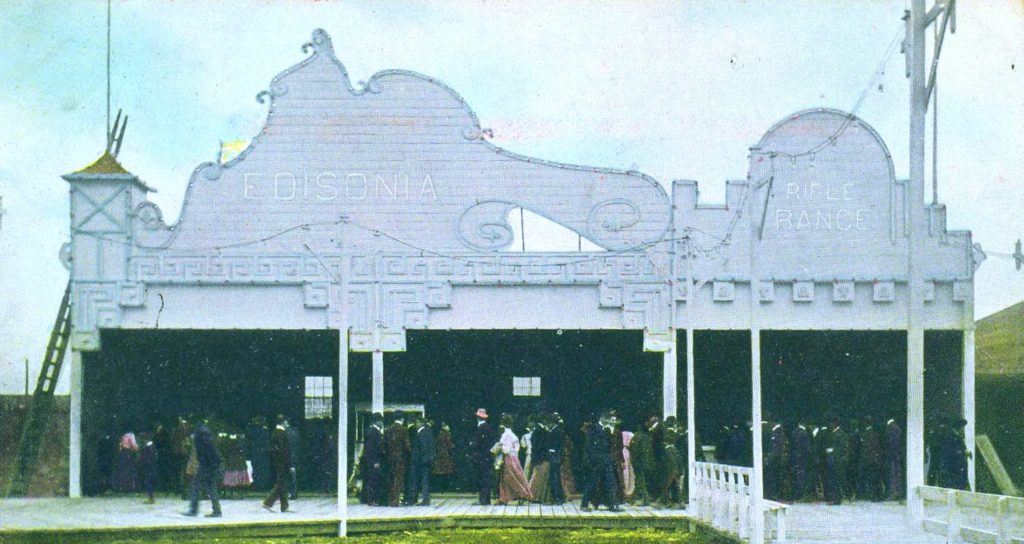
Edisonia and the rifle range at Happyland.
Source: Rob McInnes Postcard Collection (Winnipeg Public Library)
Catering to women, children and organized groups, there were expected to be up to 20 attractions along Portage Avenue that all ages would enjoy. Interesting names make it a bit ambiguous as to what some of the attractions were, and they changed throughout the life of the park. Some of the memorable attractions included a Ferris wheel, Ye Olde Mill, a vaudeville theatre, an aerial swing, a roller coaster, Chateau Alphonse, the Temple of Laughter, the Cave of the Winds, the Palace of Illusions, two carousels, the Tour of California, Edisonia, a ballroom/roller skating rink, a bandstand, a rifle range, a hippodrome, Japanese tea gardens and a restaurant. The property also included picnic areas and riverside athletic grounds.

The Ferris wheel at Happyland.
Source: Rob McInnes Postcard Collection (Winnipeg Public Library)
Happyland was managed by Thomas Morris, the same gentleman who managed the competition – River Park and Elm Park. It seems like an odd choice, but maybe amusement park managers were in short supply in Winnipeg or Morris was exceptionally good at his job? Or perhaps the owners of Happyland were counting on their amusement park being in a league of its own with no real competitors? Happyland had so many fantastical options for visitors to enjoy when other parks in Winnipeg were lucky to have even five attractions!

“Ye Old Mill” at Happyland illuminated at night.
Source: Rob McInnes Postcard Collection (Winnipeg Public Library)
Anticipation for the new park was growing as newspapers published many articles about it. Alluring stories caught the public’s attention and made them excited for the opening of Happyland, although the veracity of some of the tales was questionable. When working on the Chateau Alphonse – a “house of mirth, mystery and confusion” – a painter, C.P. Miller, became lost in the maze-like structure for the entire night, finally rescued the next morning. The not-so-happy experience apparently caused Miller to promptly quit his job and flee the city. True or not, the story surely enticed daring folks that wished to brave the Chateau’s labyrinth!
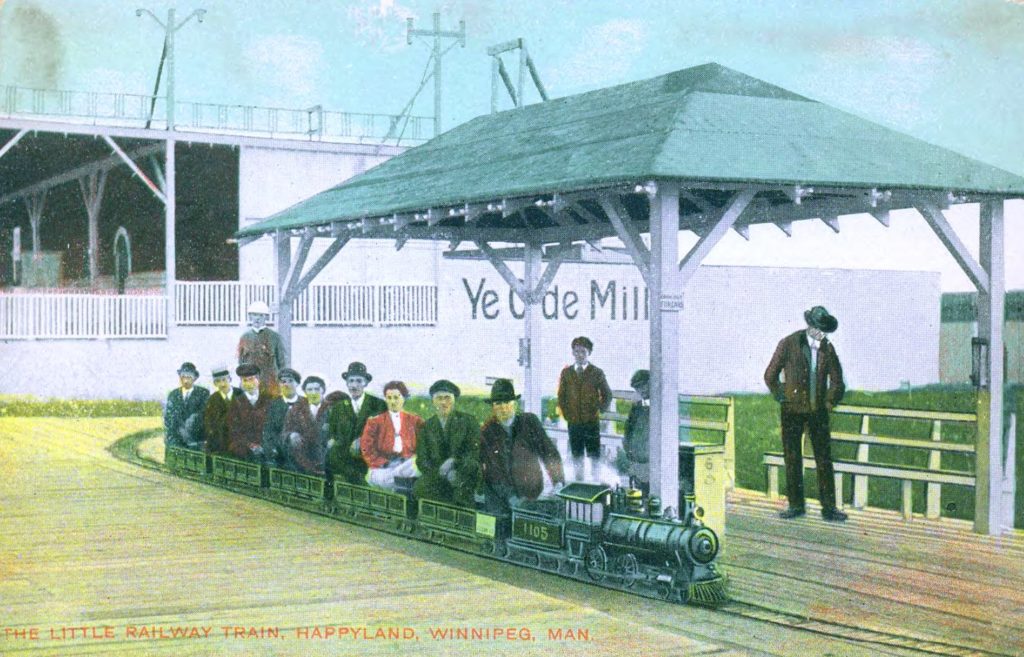
The miniature steam train at Happyland.
Source: Rob McInnes Postcard Collection (Winnipeg Public Library)
Built of simple wooden frames covered in canvas and emulating architectural style from around the world, the park was constructed in record time, allowing the opening date to be moved up. The first guests were welcomed to Happyland on May 23rd, 1906, paying just ten cents to enter. Located on the south side of Portage Avenue between Aubrey Street and Dominion Street, a new streetcar line was opened to serve the new facility. Said to have been a cold day, the park was pleased with their opening day attendance, with estimates suggesting over 8,000 people visited. The miniature steam train, “daring chauffeur” and high wire artist were the biggest crowd pleasers of the amusements open on the inaugural day.
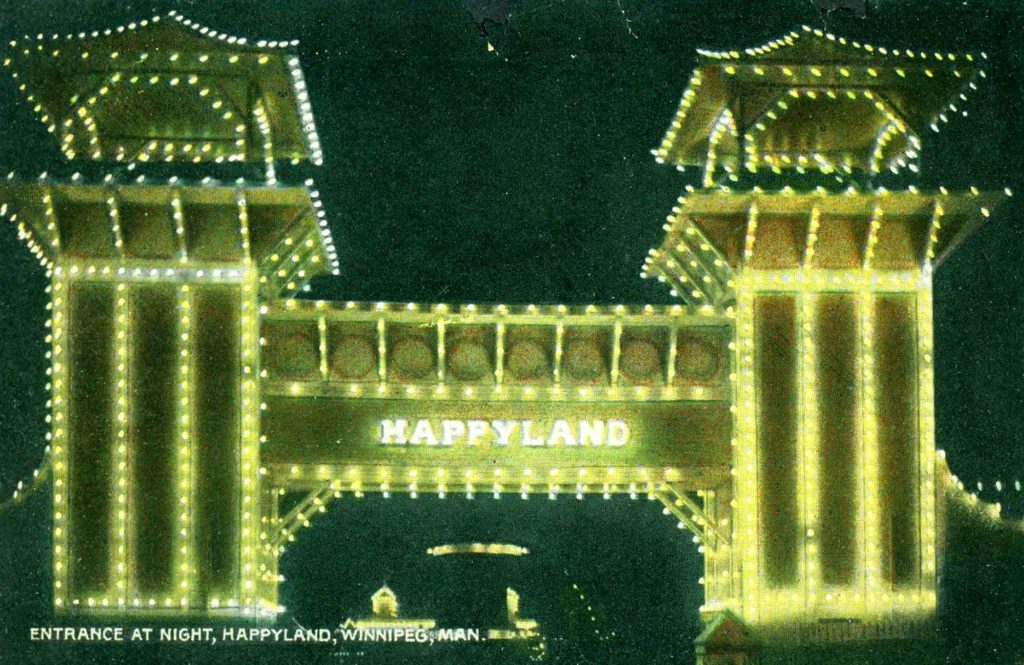
An undated image of Happyland Amusement Park entrance illuminated at night
Source: Rob McInnes Postcard Collection (Winnipeg Public Library)
Despite all the wondrous amusements at the park, the most enchanting characteristic of Happyland only appeared that evening as darkness fell, when the grounds were illuminated with about 13,000 electrical lights. The effect was magical, taking the uncomplicated buildings from modest to spectacular. The park entrance, extending about 300 feet along Portage Avenue, was fully illuminated, with two towers flanking the gate and a sign reading “HAPPYLAND” glowing brightly between them. In the distance, the glimmer of the lights on the bandstand and ballroom beckoned. It was a Winnipeg fairyland that everyone loved! The main complaint of the evening was poor streetcar service to get home. Early photos showed the park was addressing the situation with one of Winnipeg’s favourite things – parking right next to the entrance, with vehicles on one side and horses on the other.
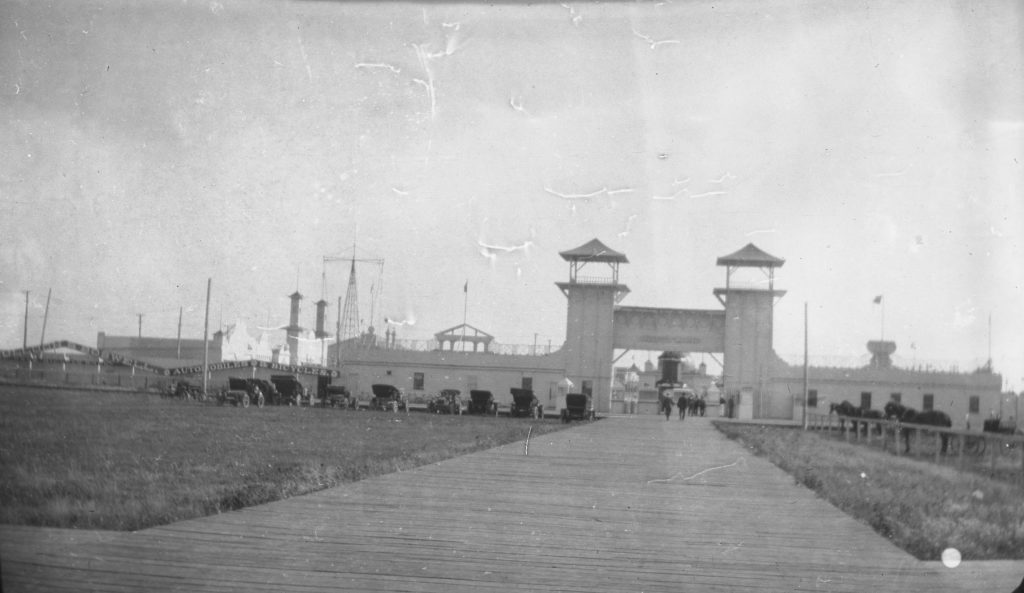
The Portage Avenue entrance to Happyland Amusement Park in 1907.
Source: Photographer Burkewood Welbourn (McCord Stewart Museum)
The opening of the park also included the first baseball game hosted at Happyland – home to the Maroons, Winnipeg’s team lost five to seven to Duluth in front of 4,000 spectators. It was the start to a spectacular summer, as everyone wanted to visit the marvelous Happyland.
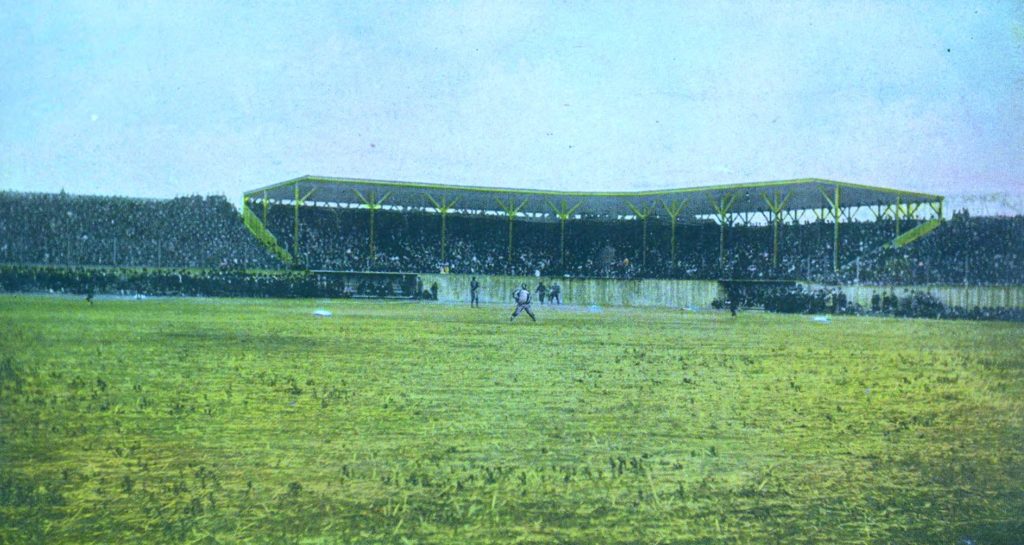
The baseball stadium at Happyland.
Source: Rob McInnes Postcard Collection (Winnipeg Public Library)
But the beautiful Happyland that initially burned so brightly all too quickly faded away. Winnipeg did not have a huge population, yet there were lots of great summer activities opening up to enjoy in and around the metropolis, spreading out the crowds. Terrible weather was also a big problem. The summer of 1907 had several bad storms, the worst of which took place on August 10th. Power was out, trees were uprooted and Happyland was in chaos. Buildings were damaged while the elephants and a lion from the visiting circus got loose, frightened but free to explore the city. All the animals were eventually found, including two of the elephants that were said to be enjoying the Assiniboine River in Headingley, squirting water and being pestered by children.
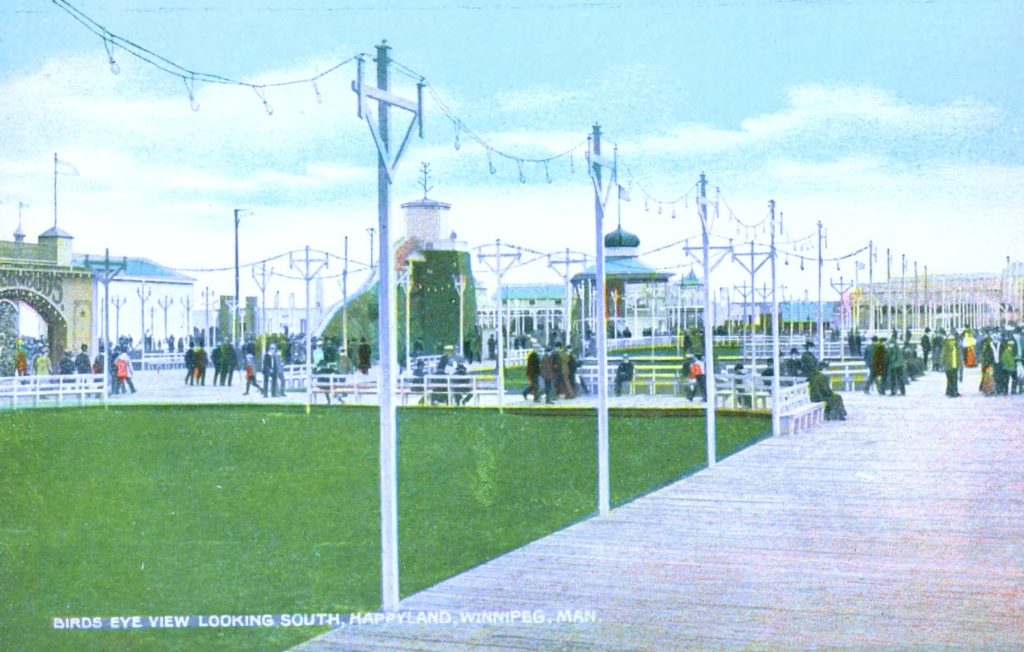
An undated image of Happyland.
Source: Rob McInnes Postcard Collection (Winnipeg Public Library)
The next year saw even more problems, with rumours swirling that the roller coaster was unsafe, the Winnipeg Maroons being forced to disband as the league failed and the fireworks never being delivered for the Canada Day celebrations. Happyland hardly made it to the end of the summer. On August 20th, 1908, it was declared bankrupt and auctioned off for a mere $6,000.
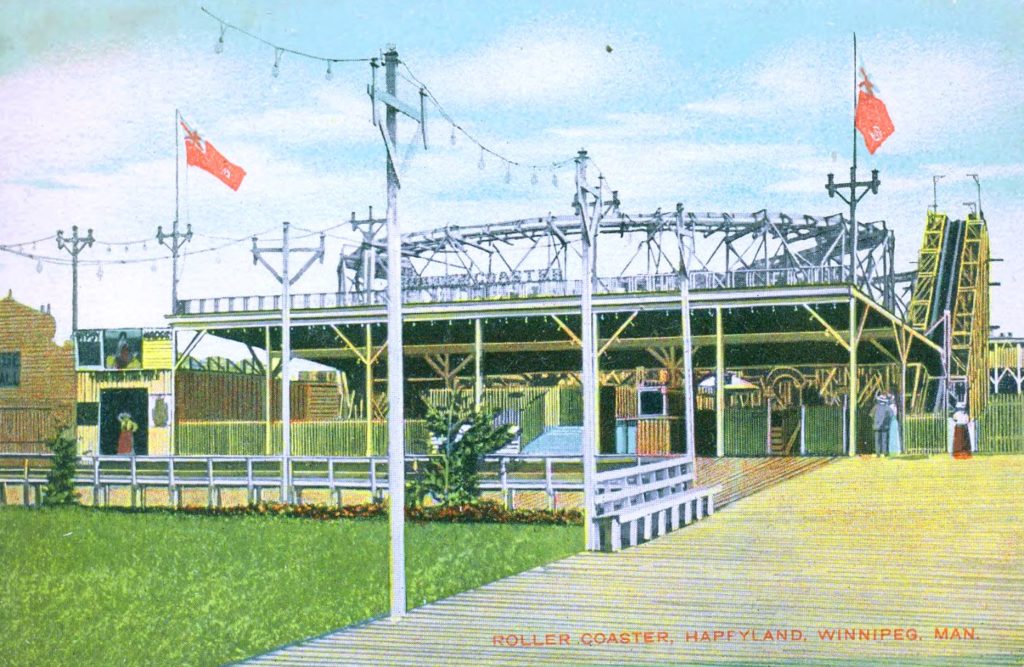
The roller coaster at Happyland.
Source: Rob McInnes Postcard Collection (Winnipeg Public Library)
The new owners of Happyland tried to keep the park going, but it never regained its glamour or grandeur. A beer garden was introduced in 1909 to try and attract more visitors, but it was yet another bad year for the park. A riot erupted on August 9th when a race between two runners; world record holder Alfred Shrubb and J.F. Fitzgerald of Edmonton, failed to get off the blocks. With 2,000 spectators ready to watch the race in the evening under the novelty of artificial lights, chaos broke out in the bleachers when efforts to turn on the lights were unsuccessful – rumoured to be sabotaged by striking electricians. The bleachers were set on fire, structures destroyed and beverages stolen from the beer gardens. Hundreds of dollars of damage was caused and no one was arrested or charged.

A streetcar stopped in front of the main entrance of Happyland in 1906 or 1907.
Source: Rob McInnes Postcard Collection (Winnipeg Public Library)
By the end of the 1909 season, Happyland was headed for bankruptcy once again, with rides put up for sale in 1910. In 1914, the owner of the park asked the City of Winnipeg to subdivide the property into residential lots and slice the property into thirds by extending Garfield Street and Sherburn Street from the north side of Portage Avenue. Happyland was considered prime real estate in the booming city, but the start of the First World War put all development plans on hold. The northern portion of the property, between Portage Avenue and Westminster Avenue, was advertised for sale in 1915, but no takers seem to have been found. The newly extended streets were finally opened in 1922, with development along them starting to gain traction in 1924.
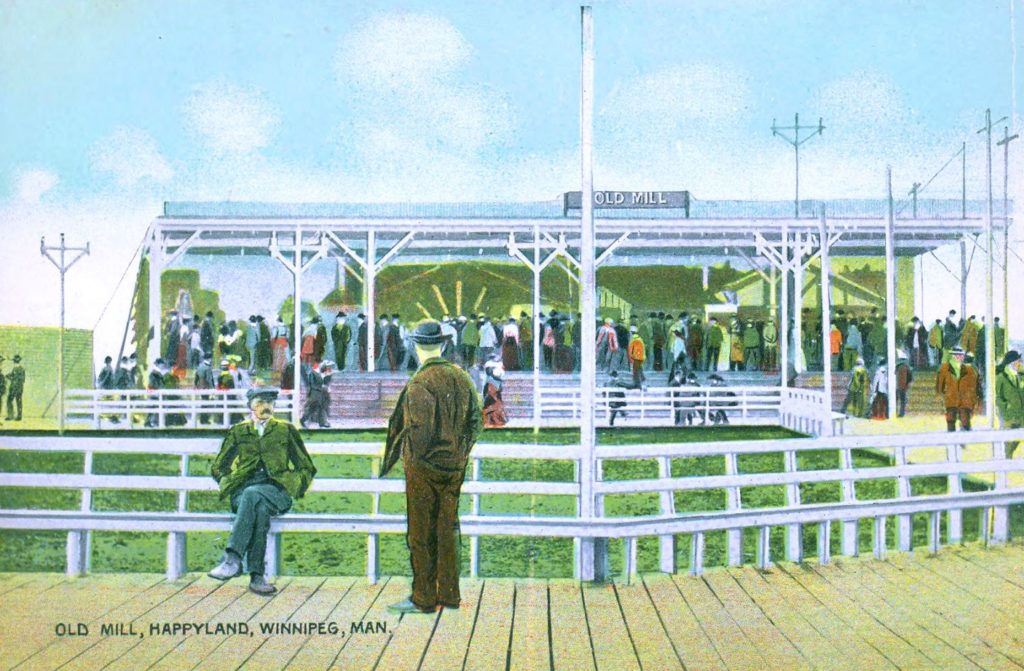
“Ye Old Mill” at Happyland.
Source: Rob McInnes Postcard Collection (Winnipeg Public Library)
For an amusement park that opened with a bang, it went out with a whisper. No one seems exactly sure when Happyland closed its grand gates for good. Did some semblance of the park hang on until the new streets sliced through the property in 1922? Or did the Happyland of our imagination disappear along with the rides in 1910? Or maybe it vanished sometime in between those events? Depending on the source, the answer is different. Reports of another stampede of escaped elephants from Happyland took place on July 29th, 1913, suggesting the park lived on after the rides departed.
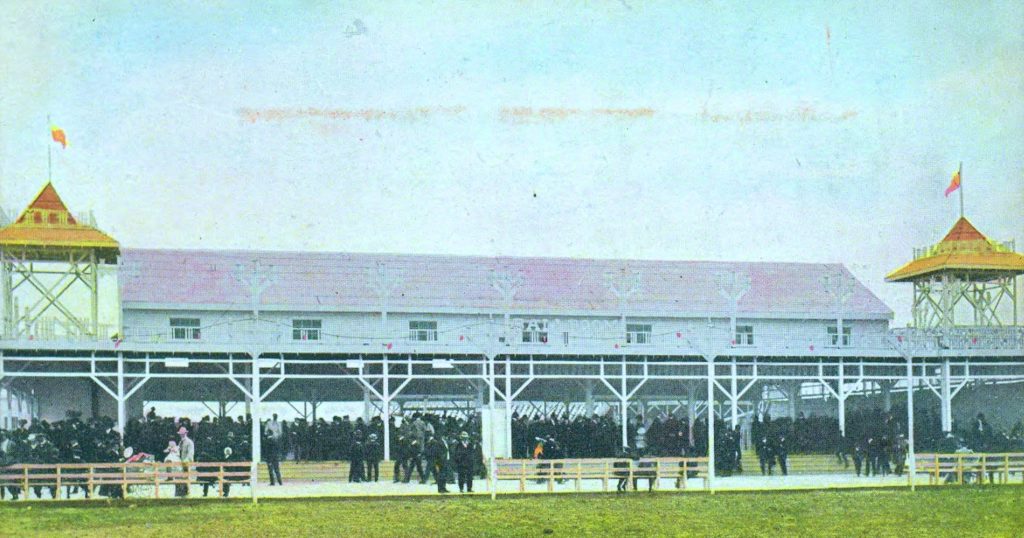
The ball room at Happyland, which was also used as a roller skating rink.
Source: Rob McInnes Postcard Collection (Winnipeg Public Library)
The one thing we can be certain of, is that Happyland did once exist and now lives on in our imaginations. It has been immortalized in Guy Maddin’s experimental documentary My Winnipeg, while the “newer” houses on Garfield Street and Sherburn Street hint at something having delayed development of the area. A Happyland Park still exists in Winnipeg, only now it is along the Seine River at the corner of Marion Street and Archibald Street, with the biggest attraction being the outdoor pool. A 19th century hymn titled “Happy Land” tells us that “There is a happy land, far, far away, where saints in glory stand, bright, bright as day… Bright in that happy land, beams every eye; kept by a Father’s hand, love cannot die.” While Winnipeg’s Happyland might not be heaven, it was a paradise where people could go to escape all their woes, if only for an afternoon. May the memory of Happyland never lose its sparkle, no matter how far away into history it may travel!
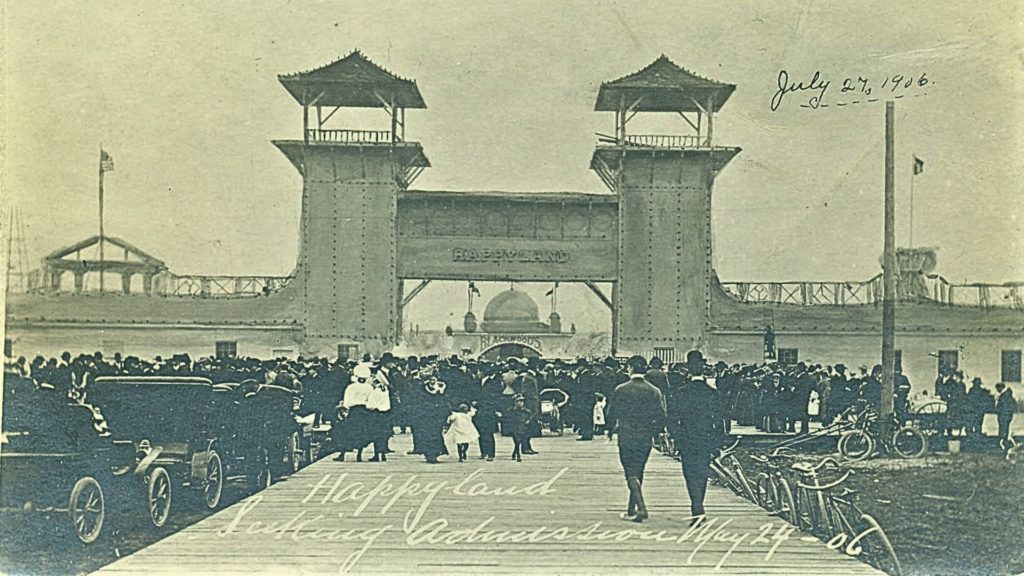
The first season of Happyland Amusement Park.
Source: Rob McInnes Postcard Collection (Winnipeg Public Library)
THANK YOU TO THE SPONSOR OF THIS BLOG POST:

Written by Heritage Winnipeg.
SOURCES:
100 years of golf: Golf buff collects history | Bonnie Bridge - Winnipeg Free Press - July 16, 1989, page 83
BIG PARK FOR AMUSEMENT: About $150,000 Will be Expended in Winnipeg - “Happyland” Selected | Winnipeg Tribune - March 1, 1906, page 5
Closed Canadian Parks: Happyland Park | Coaster Enthusiasts of Canada
Devices for entertainment | Winnipeg Tribune - March 1, 1906, page 6
GLITTER, GLAMOUR OF THE HAPPYLAND: Winnipeg’s New Amusement Park is Like a Fairy Creation | Manitoba Free Press - May 24, 1906, page 7
GOLF CLUB MEETS. Committee Appointed to Secure New Grounds. | Winnipeg Tribune Newspaper - April 4, 1906, page 11
HAPPYLAND TURNED INTO SCENE OF RIOT: Failure to Hold Race Results in Serious Damage - Attempt MAde to Burn Bleacher - Trouble With Lighting System | Winnipeg Tribune, August 10, 190, page 8
It Happened Here: Happyland Park Defeated By Many Factors After Brilliant Start | Winnipeg Free Press - June 8, 1974, page 93
It Happened Here: Happyland Park The Talk Of The Town in 1906 | Edith Paterson - Winnipeg Free Press - June 1, 1974, page 96
OPENING OF HAPPYLAND | Winnipeg Tribune - April 19, 1906, page 9
The brief, glorious life of Happyland | Jen Cameron - The Metro - May 26, 2015





